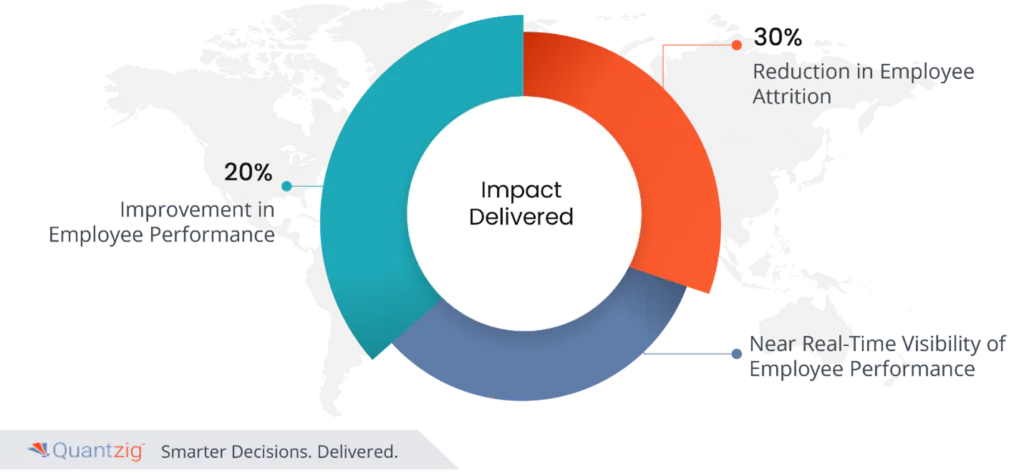
Table of Contents
Summary
Client Details: We recently helped a multinational pharma giant headquartered in Europe with annual revenue of $1Bn+.
Challenges: The client struggled to track key metrics for their employees amidst rapid growth. Manual processes and Excel-based reports hindered the accurate measurement of workforce performance. Additionally, infrequent feedback cycles limited their ability to provide timely guidance and support to employees, impacting overall workplace commitment.
Solutions:
Metric identification: Collaborating with the client, we identified crucial workforce performance metrics across different organizational levels for workforce performance management, considering variables like grade pay, designation, rewards, and tenure.
Automated tracking: We developed an automated system to capture performance data, eliminating manual errors and providing real-time insights into individual and team performances.
Feedback and Coaching: We implemented a continuous feedback system, empowering managers to provide regular guidance and coaching to employees, fostering improved workplace commitment.
Impact Delivered
All of the above initiatives resulted in:
- 20% improvement in employee performance
- 30% reduction in employee attrition
- Near real-time visibility of employee performance
About the Client
- A multinational pharma giant, headquartered in Europe with annual revenue of $1Bn+, has shown tremendous growth in recent times.
- As the client internalized various business functions, they faced the challenge of efficiently tracking key metrics for their employees.
- With the sudden increase in team size, the task of monitoring and evaluating performance became increasingly difficult for the client. It became crucial for them to find a solution that would streamline the process of tracking metrics and ensure effective management of their growing workforce.
Challenges
- The client had a good size HR team who used to measure various diversity metrics through Excel-based reports which they used to update manually. The manual process of updating the reports not only consumed a significant amount of time for the HR team but also increased the risk of errors and inconsistencies in the data. Recognizing the need for a more streamlined and automated approach, the client sought a solution to digitize and simplify the process of tracking diversity metrics. They aimed to leverage technology to improve workforce performance management, save time, and enable better analysis of their workforce diversity.
- The current performance management technique was heavily dependent on annual/quarterly feedback of the resources, leading to in-exhaustive performance reviews. The infrequent feedback cycles limited the ability to provide timely and actionable insights to employees, potentially hindering their professional development. Moreover, the extended gaps between feedback sessions made it challenging to address performance issues promptly and make necessary course corrections. The client recognized the need for a more continuous and comprehensive performance management approach that would foster regular communication, enable real-time feedback, and facilitate a more agile and responsive feedback loop.
- To address their challenges, the client sought a solution that could comprehensively track the performance of each employee, ensuring that no valuable insights were missed. They recognized the importance of timely guidance and support to help employees excel in their roles and reach their full potential. By implementing such a solution, the client aimed to enhance their ability to identify performance trends, strengths, and areas for improvement on an ongoing basis. This would enable managers and leaders to provide personalized guidance and support to employees at the right time, fostering a culture of continuous improvement and professional development. Ultimately, the client aimed to create an environment where employees felt empowered and supported in their growth journey.
Solutions
- Quantzig helped identify the key metrics for employee performance across organizational levels and segmented the employees into various clusters based on performance, grade pay, designation, R & R, tenure at the company, etc. By segmenting the workforce into these clusters, the client gained valuable insights into performance patterns, allowing them to tailor their management and development strategies accordingly. Quantzig’s analytical approach provided the client with a data-driven foundation for making informed decisions regarding employee performance, fostering a more efficient and targeted approach to guiding and supporting their workforce performance management.
- Further, we built sentiment analytics models to understand the sentiment of various employee segments for the work and organization leveraging employee surveys. These models utilized data from employee surveys, allowing for a comprehensive understanding of employee perceptions and sentiments. By analyzing the survey responses, the sentiment analytics models provided valuable insights into the level of engagement, satisfaction, and motivation within each employee segment. This information enabled the client to pinpoint areas of improvement, address concerns, and implement targeted initiatives to enhance employee experience and overall workforce performance management. The sentiment analytics models served as a powerful tool for the client to gauge employee sentiment accurately and make data-driven decisions to drive positive change within the organization.
- To support the client’s talent management efforts, advanced algorithm models were developed to identify which resources should be retained or upskilled within the organization. These models utilized a combination of performance data, skill assessments, and potential for growth to generate clear and objective recommendations. By leveraging these algorithm models, the client gained valuable insights into the skills and potential of their employees, allowing them to make informed decisions about talent retention and development. This approach helped the client optimize their workforce by identifying high-potential employees who should be nurtured for future leadership roles and also highlighted areas where upskilling initiatives could enhance employee capabilities. The advanced algorithm models provided a data-driven approach to workforce performance management, ensuring that resources were strategically allocated to maximize organizational growth and success.
- A reporting infrastructure was enabled to ensure quick and smooth decision-making. By consolidating relevant information into user-friendly reports, the client gained real-time visibility into the organization’s performance and workforce trends. The reporting infrastructure provided stakeholders with accurate and up-to-date insights, enabling them to make informed decisions promptly. It streamlined the process of accessing critical information, reducing the time and effort required to gather data manually. This improved efficiency and effectiveness in decision-making, empowering the client to proactively address challenges, capitalize on opportunities, and drive the organization toward its strategic objectives.


